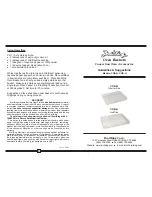
User's Guide ADI-6432 © RME
21
12. MIDI and RS232
12.1 MIDI Transmission
MADI allows for a transmission of 64 audio channels over long distances with a single line –
perfect. But what about MIDI? Be it remote control commands or sequencer data, in practice
only a single MADI line will not suffice. Therefore the ADI-6432 also has a MIDI I/O port. The
data at the MIDI input are being included into the MADI signal invisibly, and can be collected at
the MIDI output of another ADI-6432, ADI-648 or a HDSP MADI, at the other end of the MADI
line.
Technically every single MADI channel includes several additional bits, containing various in-
formation (Channel Status). RME use the usually unused
User Bit
of channel 56 (channel 28 in
96k frame mode), to transmit MIDI data invisibly within MADI, ensuring full compatibility.
The block diagram shows
the basic MIDI operation.
The MIDI input signal is
added to the MADI output
signal. The MIDI data found
in the MADI input signal will
be available at the MIDI
output. This functionality, a
bi-directional MIDI/MADI
converter, is always avail-
able, and not affected by
the REMOTE button.
The MIDI input signal will never be transferred directly from MADI to MADI, no matter how the
matrix router is set up. A MIDI cable connecting MIDI output and MIDI input of the ADI-6432, will
realize a direct pass-through of MIDI, from MADI input to MADI output.
12.2 Remote Controlling the ADI-6432
The ADI-6432 can be completely remote controlled via MIDI. The CPU shown above reacts on
specific commands. Furthermore, upon request the CPU will report the complete device status.
This includes all controls and LEDs on the front plate. Each ADI-6432 can be programmed with
its own ID, providing a separated remote control of multiple devices via a single MIDI channel. A
description of the MIDI implementation is found in chapter 17.
The button REMOTE is used to select the source of the MIDI remote control commands, and
also the destination for the ADI-6432's request replies. A push on REMOTE toggles between
MIDI port, MADI port and Off. The latter is a safety function to prevent any setup-change by any
MIDI signal. In the picture above, the MIDI commands reach the CPU via the MIDI input, and
the CPU's feedback on commands is only available at the MIDI output.
To remote control an ADI-6432 from a Hammerfall DSP via MADI, REMOTE has to be set to
MADI. As can be seen in the block diagram on the next page, this setup provides a complete
data path for MIDI in both directions.
Note: In case the remote control functionality seems not to work the device might be configured
for AES Transparent mode, see chapter 10.2.
Содержание ADI-6432
Страница 4: ...4 User s Guide ADI 6432 RME ...
Страница 5: ...User s Guide ADI 6432 RME 5 User s Guide ADI 6432 General ...
Страница 13: ...User s Guide ADI 6432 RME 13 User s Guide ADI 6432 Usage and Operation ...
Страница 25: ...User s Guide ADI 6432 RME 25 ...
Страница 28: ...28 User s Guide ADI 6432 RME ...
Страница 29: ...User s Guide ADI 6432 RME 29 User s Guide ADI 6432 Technical Reference ...
Страница 39: ...User s Guide ADI 6432 RME 39 16 Block Diagram ...
















































